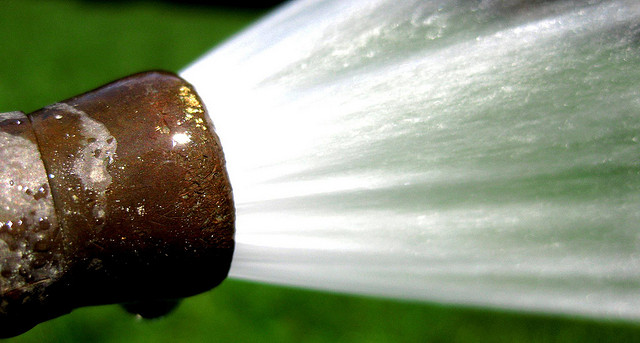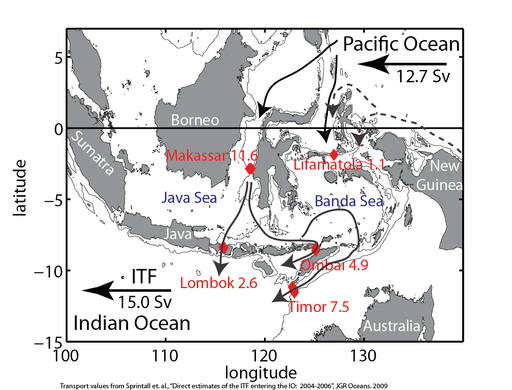
The backyard experiment any hose-owner can try. Image: Flickr / Scott Akerman
By Simon Torok
Here’s a simple backyard science experiment for you to try, which has global implications.
Grab a garden hose, turn it on, and then put your thumb over the end of it. The flow of water thins, while its power intensifies.
Okay, now multiply that by a few million and you have some idea of the impact of recent La Niña conditions on a major ocean current north of Australia.
The Indonesian Throughflow is a series of ocean currents linking the Pacific and Indian Oceans. It carries water from the Pacific to the Indian Ocean through the passages and straits of the Indonesian Archipelago.

Schematic of the ITF. Values of the flow and the major passages are indicated by red. Water enters the ITF from the western Pacific and exits into the Indian Ocean. Image: Wikipedia.
Researchers – led by Janet Sprintall at Scripps Institution of Oceanography in the United States, and including Susan Wijffels from CSIRO in Hobart – have found that the flow of water in the Indonesian Throughflow has become more shallow and intense since the late 2000s due to La Niña conditions, just as the water flow thinned and intensified while you played with that garden hose.
The paper, The Indonesian seas and their role in the coupled ocean-climate system appears in today’s online publication of the journal Nature Geoscience.
The Indonesian Throughflow is the only place in the world where warm equatorial waters flow from one ocean to another; consequently, the throughflow is an important chokepoint in the flow of heat in the climate system.
The paper suggests that human-caused climate change could make this shallowing and intensification a more dominant feature of the Indonesian Throughflow, even under El Niño conditions.
Changes in how much warm water is carried by the Indonesian Throughflow will affect the sea surface temperature, and in turn the patterns of rainfall in our region.
So you may need to think a bit more about how you use that garden hose.


24th June 2014 at 3:43 pm
Without being pedantic, the statement ‘The flow of water thins, while its power intensifies.’ can mislead people into thinking that by squeezing the end of a garden pose, somehow more power is produced. ‘Strength’ is probably a more accurate term to be used here.
23rd June 2014 at 4:48 pm
Using your example, if the ocean height increases then the Flowthrough would decrease. This slowdown would allow for a higher evaporation rate. It would cause increase rainfall throughout the area including Central & Northern Australia. That would open these areas up for agriculture & livestock. That would be a good thing, I think.